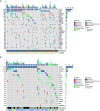Comprehensive genomic profiling of small bowel adenocarcinoma with liver metastasis
- PMID: 40386593
- PMCID: PMC12078821
- DOI: 10.21037/jgo-2025-131
Comprehensive genomic profiling of small bowel adenocarcinoma with liver metastasis
Abstract
Background: Small bowel adenocarcinoma (SBA) is a malignant tumor with a relatively low prevalence. Metastasis, especially liver metastasis (LM), is an important prognostic indicator of poor prognosis in patients with SBA. Due to the rarity of SBA, there is currently a lack of research on the characteristics of liver metastases in small intestine cancer. The aim of this study is to investigate the molecular characteristics associated with metastasis in SBA and to explore the specific molecular combinations related to LM.
Methods: A retrospective study was performed on patients with SBA who were admitted to Zhejiang Hospital and Affiliated Hangzhou First People's Hospital from July 2013 to July 2022. Sequencing with tissue was performed using a 1,021-gene panel. The least absolute shrinkage and selection operator (LASSO) algorithm was used to identify the genes for predicting LM from SBA.
Results: A total of 97 patients with SBA, including 48 patients without metastasis, 29 with LM, and 20 with extrahepatic metastasis (EHM), were enrolled in this cohort. The five genes with the highest mutation frequency in the overall samples were TP53, KRAS, APC, CDKN2A, and SMAD4, with 176 actionable mutations that had potential impact on therapy being detected in 77 (79%) cases. TP53 was significantly more frequently mutated in the LM than in the non-LM (NLM) groups. Nine genes were selected via LASSO regression to construct the LM prediction model, which generated an area under curve of 0.867. The receiver operating characteristic (ROC) curve for the validation cohort was 0.724.
Conclusions: This study elucidated the molecular characteristics of metastatic SBA and found that TP53 mutations were associated with LM in SBA. These results deepen our understanding of the occurrence and development of SBA and the potential mechanisms of LM in SBA.
Keywords: Small bowel adenocarcinoma (SBA); genomic landscape; liver metastasis (LM); prediction model; risk factor.
Copyright © 2025 AME Publishing Company. All rights reserved.
Conflict of interest statement
Conflicts of Interest: All authors have completed the ICMJE uniform disclosure form (available at https://jgo.amegroups.com/article/view/10.21037/jgo-2025-131/coif). The authors have no conflicts of interest to declare.
Figures




Similar articles
-
Identifying risk and prognostic factors for synchronous liver metastasis in small bowel adenocarcinoma: a predictive analysis using the SEER database.Front Surg. 2024 Jul 29;11:1437124. doi: 10.3389/fsurg.2024.1437124. eCollection 2024. Front Surg. 2024. PMID: 39136035 Free PMC article.
-
Molecular profiling and identification of prognostic factors in Chinese patients with small bowel adenocarcinoma.Cancer Sci. 2021 Nov;112(11):4758-4771. doi: 10.1111/cas.15119. Epub 2021 Sep 12. Cancer Sci. 2021. PMID: 34449929 Free PMC article.
-
Gene alternation of cerebrospinal fluid in patients with leptomeningeal metastases of lung adenocarcinoma using next-generation sequencing.BMC Cancer. 2022 May 25;22(1):580. doi: 10.1186/s12885-022-09597-y. BMC Cancer. 2022. PMID: 35614407 Free PMC article.
-
Molecular Landscape of Small Bowel Adenocarcinoma.Cancers (Basel). 2022 Mar 2;14(5):1287. doi: 10.3390/cancers14051287. Cancers (Basel). 2022. PMID: 35267592 Free PMC article. Review.
-
Small bowel adenocarcinoma in Crohn's disease: a systematic review and meta-analysis of the prevalence, manifestation, histopathology, and outcomes.Int J Colorectal Dis. 2022 Jan;37(1):239-250. doi: 10.1007/s00384-021-04050-1. Epub 2021 Oct 26. Int J Colorectal Dis. 2022. PMID: 34704127
References
LinkOut - more resources
Full Text Sources
Research Materials
Miscellaneous
